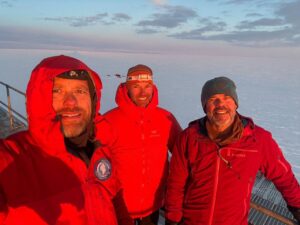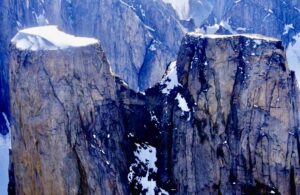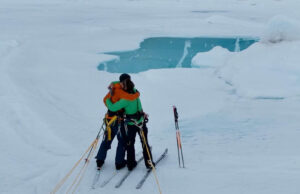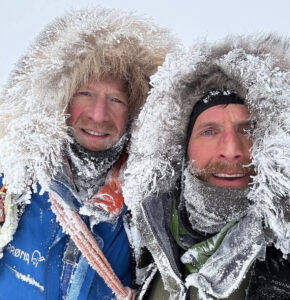I was wandering around Labrador’s small, relatively flat Eskimo Island with my boatman, an Inuk from the nearby village of Rigolet named Jimmy. The island, an amalgam of black spruce, birch trees, and naked granitic rock, had a number of old Inuit sod houses, all excavated by archaeologists. At one point, I noticed some burial cairns, one of which Jimmy said had once contained the remains of Caubvick (pre-anglicized name: Qavvik), the young Inuit woman for whom the tallest mountain in Labrador was named.

Scramblers trek up 1,652m Mount Caubvick, the high mountain in Labrador. Photo: Jerry Kobalenko
Let’s now go back in time. Along with four other Inuit from the Hamilton Inlet area, the 17-year-old Caubvick was brought to England from Labrador in October 1772 by the entrepreneur George Cartwright on the assumption that, upon seeing how civilized his country was, the “Esquimaux Indians,” as he called them, would trade with no other nation. The visitors spent much of their time in London, a place that wasn’t particularly congenial to them. “Too much noise! Too much smoke! Too many people!” one of them said.
Caubvick herself became the proverbial belle of the ball. She danced before King George III, and her portrait was painted by several well-known English artists. Cartwright’s sister Catharine was captivated by the young woman, describing her as “an ornament to her sex.” Remarkably nondiscriminatory words about an indigenous person for this period in human history!

Catches smallpox
But Caubvick wouldn’t remain this sort of ornament for very long, since she caught the reigning virus of the day, smallpox, just before Cartwright’s ship was scheduled to head back to Labrador. One by one, the other Inuit died of smallpox, but Caubvick’s case seemed somewhat less severe, and she ended up on the ship. Cartwright thought the virus resided in her pus-matted hair, so — in spite of her vehement protests — he sheared off almost all of it.
The local Inuit eagerly greeted the ship when it arrived. But when Cartwright informed them that only Caubvick had survived the trip, and when they saw her bald head and the red pustules all over her face, they went berserk. One of her cousins grabbed a rock and smashed her own head with it, apparently knocking out one of her eyes. Caubvick’s brother flung a spear at Cartwright’s boat, but this did no more damage to the boat than if (in Jimmy’s words) “he had spat on it.”
“If this is civilization, my people thought it’s better to remain savages,” Jimmy told me.

He went on to say that his people didn’t remain savages because almost none of them remained alive. For they had no resistance to the highly contagious virus Caubvick brought with her from England, nor did they know anything about social distancing, a measure that existed long before our planet’s recent debilitating virus.
Empty graves
But back to the burial cairns. All the ones I saw seemed to be empty, having either been looted or excavated by archaeologists. Empty, I should say, of human remains. But most of them were filled with algae, lichens, and mosses since the inside of the cairns were miniature ecosystems with plenty of humidity. In one of the cairns, I saw a solitary femur with a green Lecanora lichen growing on it. What a splendid color to accompany one’s journey to oblivion, I thought.
I now asked Jimmy how the remains he’d mentioned earlier could have been identified as Caubvick’s. Because the skeleton had a King George Medal around its neck, he told me, then said the skeleton in question had once been “the prettiest girl in all of Labrador.” Such sad words! Upon hearing them, I could almost feel tears brimming in my eyes.






